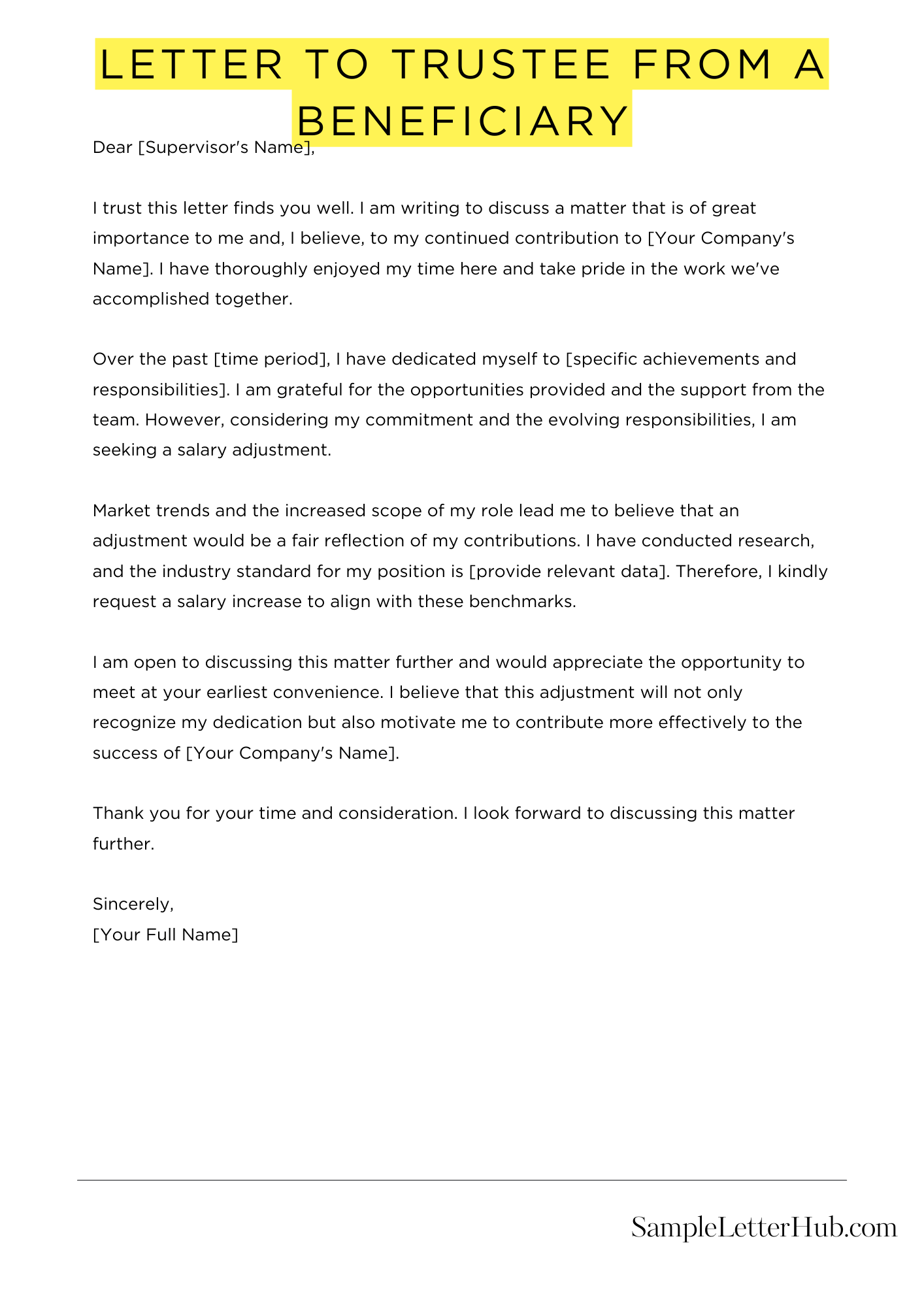A letter to a trustee from a beneficiary is a formal request or inquiry sent by a beneficiary of a trust to the trustee who is responsible for managing the trust. The purpose of this letter is to communicate the beneficiary’s concerns, requests, or questions regarding the trust.
In this article, we will provide you with templates, examples, and samples of letters to a trustee from a beneficiary. These templates and samples are designed to help you easily draft a letter that effectively conveys your message and ensures your concerns are addressed.
By using these templates and samples, you can save time and effort while ensuring that your letter is well-written and professional.
Letter to Trustee from a Beneficiary
Dear Trustee,
I am writing to you as a beneficiary of the [Trust Name] trust, established by [Grantor’s Name] on [Date]. I am writing to inquire about the status of the trust and to request certain information.
I understand that you are responsible for managing the trust’s assets and distributing them to the beneficiaries according to the terms of the trust document. I would like to know the current value of the trust’s assets and how they are being invested.
I would also like to know when I can expect to receive distributions from the trust. The trust document states that I am entitled to receive distributions of income and principal at the trustee’s discretion. I would like to know what factors you will consider when making these distributions.
I would appreciate it if you could send me a copy of the trust document and any other relevant documents that I may need to review. I would also like to schedule a meeting with you to discuss the trust in more detail.
Thank you for your time and attention to this matter. I look forward to hearing from you soon.
Sincerely,
[Your Name]

How to Write a Letter to a Trustee From a Beneficiary
Writing a letter to a trustee from a beneficiary can be a daunting task. However, by following a few simple steps, you can ensure that your letter is clear, concise, and effective.
1. Start with a formal salutation
Begin your letter with a formal salutation, such as “Dear Mr./Ms. Trustee.” If you do not know the trustee’s name, you can address the letter to “The Trustee of the [Name of Trust].”
2. State your purpose
In the first paragraph of your letter, state your purpose for writing. For example, you may be writing to request a distribution from the trust, to inquire about the status of the trust, or to provide the trustee with an update on your circumstances.
3. Provide relevant details
In the body of your letter, provide the trustee with any relevant details that support your request or inquiry. For example, if you are requesting a distribution from the trust, you should state the amount of money you are requesting and the purpose for which you need the money. If you are inquiring about the status of the trust, you should ask specific questions about the trust’s assets, liabilities, and income.
4. Be clear and concise
When writing your letter, be clear and concise. Avoid using jargon or technical terms that the trustee may not understand. Instead, use plain English that is easy to read and understand.
5. Be respectful
Remember that the trustee is a fiduciary who has a duty to act in the best interests of the beneficiaries. When writing your letter, be respectful of the trustee’s time and position. Avoid making demands or accusations. Instead, focus on stating your needs and requests in a polite and professional manner.
6. Close with a call to action
In the closing paragraph of your letter, state your call to action. For example, you may ask the trustee to approve your request for a distribution, to provide you with an update on the status of the trust, or to meet with you to discuss your concerns.
7. Sign your letter
End your letter with a formal closing, such as “Sincerely,” followed by your signature. If you are sending your letter electronically, you can type your name in the signature line.
FAQs about Letter To Trustee From A Beneficiary
What is a letter to a trustee from a beneficiary?
A letter to a trustee from a beneficiary is a formal communication sent by a beneficiary to the trustee of a trust. The letter typically requests information about the trust, the beneficiary’s interest in the trust, and the trustee’s administration of the trust.
What are the most common reasons for writing a letter to a trustee?
Beneficiaries typically write letters to trustees to request information about the trust, the beneficiary’s interest in the trust, and the trustee’s administration of the trust. Other reasons for writing a letter to a trustee may include:
- To request a copy of the trust document
- To inquire about the value of the trust assets
- To request an accounting of the trust’s income and expenses
- To request a distribution from the trust
- To object to the trustee’s administration of the trust
What information should I include in a letter to a trustee?
When writing a letter to a trustee, you should include the following information:
- Your name and contact information
- The name of the trust
- The date of the trust
- The name of the trustee
- The reason for your letter
- Any specific questions you have for the trustee
How should I send a letter to a trustee?
You can send a letter to a trustee by mail, email, or fax. If you are sending the letter by mail, you should send it certified mail, return receipt requested. This will provide you with proof that the trustee received the letter.
What should I do if I do not receive a response from the trustee?
If you do not receive a response from the trustee within a reasonable amount of time, you may want to contact the trustee again. You can also consider contacting an attorney to discuss your options.

